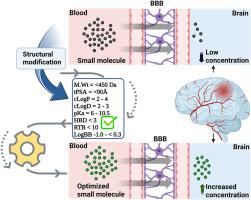突破障碍:克服血脑屏障和增强中枢神经系统渗透的药物化学策略和先进的硅方法
IF 5.9
2区 医学
Q1 CHEMISTRY, MEDICINAL
引用次数: 0
摘要
将小分子输送到大脑和中枢神经系统(CNS)受到限制性血脑屏障(BBB)的极大阻碍,该屏障选择性地允许必需分子而排除有毒分子。膜的这种选择性渗透性也对将小分子输送到大脑以获得治疗效果提出了挑战。药物方法,如设计前药,与脂质体/免疫脂质体结合,并配制成纳米颗粒,以增加血脑屏障的渗透。尽管做出了这些努力,但大脑无法达到最佳浓度的挑战依然存在。在药物发现的早期阶段修改小分子是设计能够穿透血脑屏障的药物的一种很有前途的策略。为了实现这一目标,必须微调物理化学参数,以提高渗透率,同时小心避免毒性。在这篇综述中,我们阐明了通过调整分子量、亲脂性、pKa、氢键供体数量、可旋转键数量、拓扑极性表面积和脑内药物浓度与血液中药物浓度之比(LogBB)来优化小分子的最新策略。本综述将使研究人员能够通过整合经验和计算策略,快速采用框架来克服中枢神经系统药物发现中的血脑屏障挑战。本文提出的见解旨在使研究人员能够开发有效的血脑屏障穿透小分子,推进中枢神经系统治疗,改善神经系统疾病和脑转移的治疗。本文章由计算机程序翻译,如有差异,请以英文原文为准。

Breaking Barriers: Medicinal Chemistry Strategies and Advanced In-Silico Approaches for Overcoming the BBB and Enhancing CNS Penetration
Delivering small molecules to the brain and central nervous system (CNS) is greatly hindered by the restrictive blood-brain barrier (BBB), which selectively permits essential molecules while excluding toxic molecules. This selective permeability feature of the membrane also poses a challenge in delivering small molecules to the brain intended for therapeutic benefits. Pharmaceutical approaches such as designing a prodrug, conjugating with liposomes/immunoliposomes, and formulating as nanoparticles have been employed to increase BBB penetration. Despite these efforts, the challenge of suboptimal concentration reaching the brain persists. Modifying small molecules in the early stages of drug discovery is a promising strategy for designing drugs that can penetrate the BBB. To achieve this, it is essential to fine-tune physicochemical parameters to enhance permeability while carefully avoiding toxicity. In this review, we elucidate the most recent strategies for optimizing small molecules by adjusting molecular weight, lipophilicity, pKa, number of hydrogen bond donors, number of rotatable bonds, topological polar surface area, and the ratio of drug concentration in the brain to that in the blood (LogBB). This review will enable researchers to rapidly adopt a framework to overcome BBB challenges in CNS drug discovery by integrating empirical and computational strategies. The insights presented here aim to empower researchers to develop effective BBB-penetrable small molecules, advancing CNS therapeutics and improving the treatment of neurological disorders and brain metastasis.
求助全文
通过发布文献求助,成功后即可免费获取论文全文。
去求助
来源期刊
CiteScore
11.70
自引率
9.00%
发文量
863
审稿时长
29 days
期刊介绍:
The European Journal of Medicinal Chemistry is a global journal that publishes studies on all aspects of medicinal chemistry. It provides a medium for publication of original papers and also welcomes critical review papers.
A typical paper would report on the organic synthesis, characterization and pharmacological evaluation of compounds. Other topics of interest are drug design, QSAR, molecular modeling, drug-receptor interactions, molecular aspects of drug metabolism, prodrug synthesis and drug targeting. The journal expects manuscripts to present the rational for a study, provide insight into the design of compounds or understanding of mechanism, or clarify the targets.

 求助内容:
求助内容: 应助结果提醒方式:
应助结果提醒方式:


